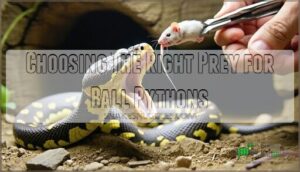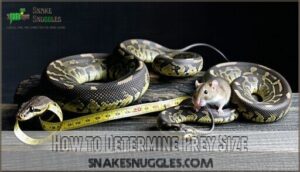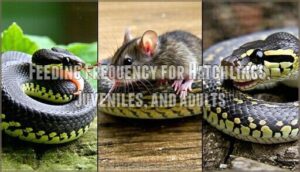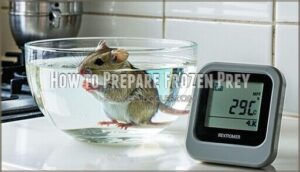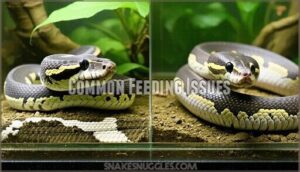This site is supported by our readers. We may earn a commission, at no cost to you, if you purchase through links.
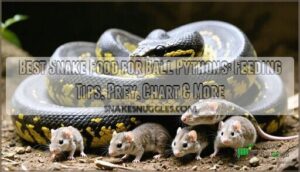 The best snake food for ball pythons is appropriately sized rodents like mice or rats, offered either frozen-thawed or pre-killed.
The best snake food for ball pythons is appropriately sized rodents like mice or rats, offered either frozen-thawed or pre-killed.
Feeding frozen-thawed prey is safer, as it minimizes the risk of injury from a defensive rodent.
Select prey that’s about the same width as your python’s widest part; too small, and they’ll stay hungry; too large, and it’s like swallowing a basketball.
Hatchlings usually start with pinky mice, while adults prefer medium or large rats.
Always thaw prey thoroughly and warm it slightly—nobody enjoys a frozen dinner!
Want to keep your snake healthy? Stick to whole prey and steer clear of live feeding, as it is crucial for their well-being to have a safe environment.
Table Of Contents
- Key Takeaways
- Choosing The Right Prey for Ball Pythons
- Top 3 Best Snake Foods for Ball Pythons
- Prey Size and Feeding Frequency
- Safe Feeding Practices for Ball Pythons
- Nutritional Supplements for Ball Pythons
- Diet Alternatives for Ball Pythons
- Feeding Habits and Guidelines
- Common Feeding Issues
- Preparing and Storing Prey
- Monitoring and Adjusting Feeding Habits
- Frequently Asked Questions (FAQs)
- What is the best food for ball pythons?
- What are pythons’ favorite foods?
- What is the best stuff for a ball python?
- What is the feeding schedule for a ball python?
- Should you feed a ball python?
- Can ball pythons eat thawed prey?
- What size prey should a ball python eat?
- Do ball pythons eat reptilinks?
- What can I feed my ball python besides mice?
- What is the best snake food?
- Conclusion
Key Takeaways
- Feed your ball python frozen-thawed rodents like mice or rats, sized 1-1.25 times their body’s widest part, for safe and nutritious meals.
- Stick to a feeding schedule: hatchlings eat every 5-7 days, juveniles weekly or bi-weekly, and adults every 10-14 days.
- Thaw prey properly in the fridge or warm water, and check it’s at 98-100°F before offering for a safer and more successful feed.
- Avoid live prey to protect your snake from injuries; frozen-thawed options are safer and mimic the warmth of natural prey.
Choosing The Right Prey for Ball Pythons
Selecting the right prey for your ball python guarantees proper nutrition and supports healthy growth.
Proper prey selection ensures your ball python thrives with optimal nutrition, supporting healthy growth and well-being.
Focus on prey that matches your snake’s size and dietary needs, prioritizing safety and convenience with frozen-thawed options.
Types of Prey for Ball Pythons
In the case of ball pythons, stick to rodent varieties like frozen mice or frozen rats—they’re the safest and most convenient option.
Occasionally, incorporate bird options or lizards for variety.
Ensuring whole prey offers full nutritional value, including bones and organs.
Reliable prey sourcing matters; purchase ethically and handle with care.
Remember, the prey size should match your snake’s width for easy digestion.
How to Select Prey Based on Snake Size
Matching prey size to your ball python’s mid-body diameter—1 to 1.25 times—is key to preventing regurgitation and promoting nutritional adequacy.
Use this quick prey size guide:
- Baby snakes: Pinkie mice.
- Juveniles: Hopper mice or fuzzies.
- Young adults: Small frozen rats.
- Large adults: Medium frozen rats.
Stick to this ratio to avoid overfeeding or underfeeding.
Where to Buy Prey for Ball Pythons
When looking for prey for your ball python, you’ve got plenty of options. Local breeders, pet stores, or even reptile expos often have the best feeders on hand, including both live and frozen-thawed rodents.
Online retailers like Rodent Pro and Coldblooded Cafe are great for quality and variety, while rodent farms cater to bulk buyers. For convenience, try stores specializing in reptile supplies.
Always verify the prey size is appropriate for your snake’s midsection, and thaw frozen prey thoroughly if feeding frozen-thawed rodents. Some owners choose live feeding to provide natural hunting stimulation.
Top 3 Best Snake Foods for Ball Pythons
To keep your ball python healthy and thriving, you’ll need more than just the right prey—it’s vital to have essential tools and supplements as well.
Let’s explore the top three snake food accessories that make feeding efficient and beneficial for your snake.
1. Digital Kitchen Scale 22lb Grams Ounces

In the context of feeding your ball python, a reliable digital kitchen scale, like the Nicewell MQD-C018, can make all the difference.
Its precise measurements in grams, ounces, and pounds let you easily size prey to match your snake’s midsection diameter—essential for proper digestion.
The sleek, tempered glass platform is easy to clean and features a compact design that fits conveniently in your kitchen or reptile area.
With touch-sensitive buttons and a large LCD display, using this scale feels effortless.
Whether you’re measuring pinkie mice or medium rats, this sturdy tool removes any guesswork, ensuring your python’s meals are just right.
Accurate feeding starts with accurate measurements!
Best For: Pet owners, cooking enthusiasts, or individuals needing precise measurements for daily tasks, such as measuring food for reptiles, baking, or portion control.
- Highly accurate measurements with easy unit conversion for a variety of needs.
- Sleek, easy-to-clean design with a durable tempered glass platform.
- Compact, lightweight, and includes convenient storage features like a hook.
- Sensitive touch buttons may occasionally activate unintentionally.
- Requires a completely flat surface for accurate readings.
- Auto-off feature may interrupt tasks if left idle for too long.
2. Reptile Amphibian Multivitamin Blue Bottle
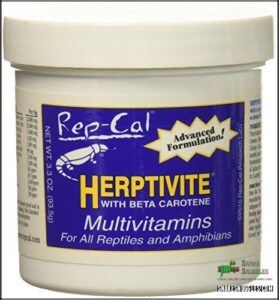
For a well-rounded diet, ball pythons benefit greatly from additional nutritional support, and the Reptile Amphibian Multivitamin Blue Bottle is a game-changer.
Designed with cutting-edge reptile nutrition research, it’s packed with sea vegetation, essential amino acids, and essential vitamins, ensuring your snake thrives.
The fine powder consistency makes it easy to coat prey items like mice or rats evenly, sticking well for every feeding. Since it’s flavorless, most ball pythons accept it without fuss—perfect for picky eaters.
However, if your snake hesitates, mixing it with calcium powder can improve acceptance. Using this supplement regularly supports growth, energy, and overall health while avoiding vitamin A toxicity.
It’s also long-lasting, even with frequent use, offering great value. Always follow the label’s directions for best results, and watch your ball python flourish with each meal!
Best For: Reptile and amphibian owners looking for a high-quality multivitamin supplement to support growth and overall health.
- Some pets reject the flavor, requiring mixing with calcium for better acceptance.
- Extra preparation steps needed due to separate calcium mixing.
- Minor design flaws in packaging, like the protective coating on grommets.
- Fine powder consistency sticks well to food and is long-lasting.
- Packed with sea vegetation, amino acids, and essential vitamins for balanced nutrition.
- Developed with advanced reptile nutritional research, ensuring effectiveness.
3. Zoo Med Reptile Rock Corner Water Dish
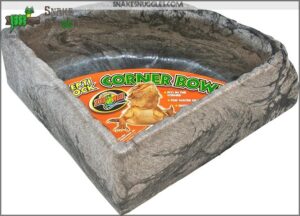
The Zoo Med Reptile Rock Corner Water Dish is a must-have for ball python care.
Its sturdy, all-natural stone design fits snugly in tank corners, maximizing space while offering a reliable spot for hydration or soaking.
The dish’s durable surface resists cracks and leaks, making cleanup hassle-free.
However, moving it when full can feel like a mini workout, thanks to its weight.
Sticker residue may require extra elbow grease to remove, but it’s worth the effort.
With its generous size, even larger ball pythons can submerge comfortably, aiding shedding.
This practical and dependable dish keeps your snake happy and healthy, making it a great choice for ball python care.
Best For: Reptile owners, especially those with ball pythons, looking for a durable, space-saving water or soaking dish.
- Durable and resistant to cracks or leaks
- Generous size accommodates larger snakes like ball pythons
- Fits snugly in tank corners to maximize space
- Heavy when full, making it inconvenient to move
- Adhesive sticker residue can be hard to remove
- Coloring and design may lack aesthetic appeal
Prey Size and Feeding Frequency
Getting the right prey size and feeding schedule is critical for keeping your ball python healthy and thriving.
You’ll need to match the prey to your snake’s body size and adjust feeding frequency as it grows to guarantee proper digestion and nutrition.
How to Determine Prey Size
Getting prey size right keeps your ball python healthy and happy. Use the Prey Body Ratio: select prey 1–1.25 times the snake’s mid-body diameter.
- Measure your python’s girth using soft tape.
- Choose rodents matching the Acceptable Size Range.
- Avoiding Overfeeding prevents obesity.
- Preventing Regurgitation avoids stress.
- Adjust rodent size as python growth progresses.
Feeding Frequency for Hatchlings, Juveniles, and Adults
Feeding your ball python requires a schedule that grows with them.
Hatchlings eat every 5-7 days to support growth spurts, while juveniles shift to weekly or bi-weekly meals.
Mature adults settle for 10-14 day intervals, enjoying up to 12 meals yearly.
Monitor body condition and growth to avoid obesity.
| Life Stage | Feeding Frequency | Focus |
|---|---|---|
| Hatchlings | Every 5-7 days | Rapid growth |
| Juveniles | Weekly/Bi-weekly | Steady gains |
| Adults | Every 10-14 days | Weight control |
Safe Feeding Practices for Ball Pythons
You’ll want to make certain your ball python’s feeding routine is both safe and effective to support its health.
Proper preparation, careful prey handling, and avoiding common mistakes can make a big difference in your snake’s overall well-being.
How to Prepare Frozen Prey
Before feeding your ball python, safe preparation of frozen-thawed rodents guarantees their health.
Start by thawing prey overnight in the fridge to control bacteria growth. Short on time? Use a cold-water bath for quicker thawing.
Once thawed, warm the rodent in lukewarm water (98-100°F) for 15-30 minutes. A digital thermometer helps maintain precise temperature control. Many keepers purchase a reptile thermometer online for accuracy.
Proper warming techniques encourage strikes by mimicking live prey warmth. Always check the rodent’s temperature before offering it. Thoughtful snake feeding preparation avoids prey safety concerns, guaranteeing a healthy, happy reptile.
Stick to appropriate thawing methods for both safety and feeding success!
Avoiding Common Feeding Mistakes
Feeding mistakes can harm your ball python, but they’re easy to avoid with a little care.
Feeding mistakes are preventable—simple care ensures your ball python stays healthy, happy, and thriving with every meal.
Remember these tips to keep your snake happy and healthy:
- Prey Size: Don’t force large meals—offer prey 1-1.25 times the widest part of your snake’s body to avoid overfeeding dangers and regurgitation.
- Thawing: Improper thawing or wrong temperatures (too cold or hot) can cause refusal to eat.
- Handling: Skip post-meal handling to prevent stress and regurgitation.
- Live Prey Risks: Always supervise live prey to avoid injury.
Stick to this routine, and feeding mistakes won’t interfere with your snake’s well-being!
Nutritional Supplements for Ball Pythons
You mightn’t think of snakes needing supplements, but ensuring your ball python gets enough calcium and vitamins is essential for its overall health.
Use high-quality powders sparingly to fill nutritional gaps, especially if your snake doesn’t eat a varied diet, which can be a critical factor in maintaining its health.
Calcium and Multivitamin Powder
Calcium and multivitamin powders are like backup insurance for your ball python’s diet, ensuring strong bones and proper growth.
These nutritional supplements are particularly handy if your snake’s primary food—whole rodents—is lacking.
It’s important to remember that whole prey nutrition is critical for ball pythons.
Lightly dust prey with a balanced mix of calcium and Vitamin D3 powders every other feeding.
Stick to trusted reptile supply brands for quality.
Watch for deficiency symptoms, like sluggishness or weak movement, and consult a vet if unsure about dosage guidelines or powder application.
How to Supplement With Calcium and Vitamin D
Supplementing your ball python with calcium and vitamin D guarantees healthy bones and overall growth.
Follow this schedule:
- Calcium Dusting: Lightly dust prey every second feeding for adults with a trusted calcium powder.
- Vitamin D3 Importance: Use supplements containing D3 if your snake lacks UVB exposure.
- Observing Deficiency Signs: Monitor for lethargy or weak movements—signs of supplement imbalance.
Diet Alternatives for Ball Pythons
You’ve got more options for feeding your ball python than just mice and rats, but it’s important to understand their nutritional needs.
Alternatives like commercial snake food or occasional treats, such as crickets or hamsters, can broaden their diet while keeping them healthy.
Commercial Snake Food
Commercial snake food simplifies your ball python’s diet while offering balanced nutrition.
With various snake food types available, knowing what suits your python can prevent nutrient deficiencies.
Look for reputable commercial brands that prioritize food safety and nutrient-rich options.
Here’s a quick comparison:
| Brand | Nutritional Highlights | Pros & Cons |
|---|---|---|
| MiceDirect | Protein-rich | Easy storage, pricey |
| RodentPro | Balanced diet | Reliable, bulk sizes |
| Big Cheese | Quality assurance | Limited variety |
| Reptilinks | Unique options | Higher cost |
Crickets and Hamsters as Treats
Occasionally adding crickets and hamsters as treats can diversify your ball python’s diet, but they’re not staple foods. While hamsters match rodent nutrition, their potential health risks, like biting, make pre-killed options safer. Crickets, however, lack essential nutrients needed for proper growth.
Stick to these ethical, safe guidelines:
- Limit treats to once every few weeks.
- Choose pre-killed hamsters to avoid injuries.
- Never rely on crickets for primary feeding.
- Supervise feeding to guarantee safety.
- Prioritize alternative treats like small chicks or quail.
Moderation guarantees your snake thrives with balanced, safe diet alternatives.
Feeding Habits and Guidelines
Feeding your ball python correctly means understanding its natural feeding habits and providing appropriately sized prey at the right intervals.
Stick to a consistent feeding schedule, as this promotes proper growth, digestion, and overall health.
Understanding Ball Python Feeding Habits
Ball pythons are expert hunters, relying on heat-sensing pits and scent detection to locate prey.
Captive adaptations mean your snake thrives on a natural diet of frozen-thawed rodents, mimicking their wild routine. Feed in a safe, calm spot to support their digestive process.
| Stage | Frequency | Prey Type | Notes |
|---|---|---|---|
| Hatchling | Every 5 days | Pinkie mice | Small size guarantees digestion. |
| Juvenile | Every 7–10 days | Small rats/mice | Adjust size as they grow. |
| Subadult | Every 10–14 days | Medium rats | Watch body condition. |
| Adult | Every 14–21 days | Large rats | Prevent feeding overweight. |
Feeding Charts and Guidelines
Feeding your ball python isn’t a guessing game; it’s a thoughtful process.
A feeding chart helps balance their diet and guarantee they thrive.
- Growth Tracking: Adjust feeding based on size and age.
- Meal Spacing: Allow proper digestion time.
- Portion Control: Keep prey size manageable.
- Dietary Adjustments: Monitor weight, using your snake’s “plump sausage” shape as a guide.
Common Feeding Issues
Feeding issues like overfeeding or appetite loss can affect your ball python’s health and well-being, but they’re often preventable with proper care.
Understanding the causes behind these problems helps you address them effectively and keep your snake on track, which is crucial for maintaining its health and overall well-being.
Overfeeding and Obesity
Overfeeding can cause snake obesity, leading to fat rolls, scale separation, and potential health risks.
Stick to your ball python’s proper feeding schedule—don’t spoil them with frequent meals. Monitor their weight and body shape regularly; a balanced ball python diet is essential.
If necessary, use corrective measures like adjusted feeding and enrichment to keep them active and healthy.
For humans, drastically cutting calories can also lead to obesity-related health issues, similar to the effects of the snake diet’s extreme restrictions.
Refusal to Eat and How to Encourage Eating
When your ball python refuses to eat, it’s often linked to environmental factors, shedding, or underlying illnesses.
Stubborn eaters might skip meals during seasonal fasting or due to stress. Start by checking enclosure conditions like temperature and humidity.
For reluctant eaters, scenting techniques—rubbing prey with chicken broth—can help. If snake feeding refusal persists, try smaller prey or assist feeding.
Remember, never force-feed unless directed by a vet. Persistent refusal warrants a vet consultation to identify any hidden health issues.
Preparing and Storing Prey
Properly preparing and storing frozen prey guarantees your ball python receives safe and nutritious meals every time.
Thaw frozen prey safely in the refrigerator or warm water, and store unused prey in a sealed container in your freezer to maintain quality.
Thawing and Warming Frozen Prey
Thawing frozen-thawed rodents requires patience and precise thawing methods.
Start by refrigerating them overnight to guarantee safe temperature control and reduce bacterial growth.
Once thawed, use warming techniques, like placing the prey in warm water, to mimic live prey conditions.
Proper preparation often involves specialized thawing equipment.
Aim for 98-100°F, using a temperature gun to avoid safety concerns during the snake feeding process.
Prey size matters—make certain it’s the right fit for your snake’s body.
Proper preparation guarantees your snake safely enjoys its meal with the correct prey size.
Storing Prey for Future Use
Proper storage keeps your snake food fresh and safe.
For storing prey for future use, follow these tips:
- Freezer Organization: Use airtight containers or vacuum-sealed bags to prevent freezerburn and odors.
- Storage Duration: Label frozenthawed rodents with purchase dates; use within six months.
- Bulk Buying Tips: Stock up on appropriate prey sizes to save time and money.
- Thawing Methods: Always defrost prey in the fridge or warm water, never at room temperature or in the microwave.
To avoid contamination, implement safe food handling.
Monitoring and Adjusting Feeding Habits
You need to regularly monitor your ball python’s weight and body condition to verify it’s healthy and thriving.
Adjust feeding frequency and prey size as needed, keeping in mind factors like age, activity level, and growth rate.
Monitoring Weight and Body Condition
Monitoring your ball python’s weight and body condition is like fine-tuning an instrument—it keeps everything in harmony.
Regular weight tracking helps spot obesity signs or underweight risks before issues escalate.
Check for a balanced midsection; neither saggy nor overly thin.
Pay attention during shedding, as it reflects snake nutrition and overall health.
Stick to your ball python diet plan, adjusting prey size as necessary to support proper growth and avoid excess weight.
Adjusting Feeding Frequency and Prey Size
Adjusting your ball python’s feeding schedule and prey size is like solving a puzzle that changes with age, growth, and individual needs.
Young snakes, with rapid growth rates, require smaller prey more often—every 5-7 days. As they age and slow down growth, they’ll shift to eating larger prey less frequently, with adults feeding every 2-3 weeks.
Use your python’s body as a guide for prey size; it should be 1 to 1.25 times the width of the snake’s midsection. Oversized prey can lead to regurgitation or injury, while smaller prey may not support proper growth.
Always consider individual variation—every snake has unique needs. During shedding, digestion slows, so adjust feeding accordingly. A helpful tool for determining the appropriate feeding schedule is a snake feeding schedule.
Careful attention helps build an obesity-free, healthy, thriving ball python diet, ensuring a healthy and thriving environment for your pet, with proper growth and development.
Frequently Asked Questions (FAQs)
What is the best food for ball pythons?
You wouldn’t feed a tiger salad, right?
For ball pythons, frozen-thawed mice or rats are your safest, most nutritious choice, sized 1-25 times their body’s thickest part.
It’s simple, safe, and effective!
What are pythons’ favorite foods?
Ball pythons love munching on rodents like mice and rats, particularly when these are around the size of their midsection.
Stick to frozen-thawed options for safety, and warm them slightly to mimic fresh prey.
What is the best stuff for a ball python?
The best essentials for a ball python include frozen-thawed rodents like appropriately-sized mice or rats for meals.
A stable enclosure with proper heat and humidity, and fresh water are also necessary.
Avoid live prey, oversized food, or incomplete meals.
What is the feeding schedule for a ball python?
The rhythm of a ball python’s life beats with its feedings: young snakes thrive on a meal every 5-7 days, while adults savor theirs every 10-14 days, ensuring steady growth and health.
The feeding schedule is crucial for the overall health of the ball python.
Should you feed a ball python?
You absolutely should feed your ball python, but timing matters.
Offer appropriately sized prey every 7–14 days, depending on its age and size.
Stick to frozen-thawed rodents for safety and ease, ensuring proper digestion.
Can ball pythons eat thawed prey?
Yes, you can feed a ball python thawed prey.
Defrost frozen rodents completely, warm them to about 98-100°F, and use feeding tongs to present them safely.
It’s a practical, safe feeding option.
What size prey should a ball python eat?
Did you know a ball python’s prey size should match 1 to 25 times its mid-body diameter?
Offering properly sized rodents guarantees safe digestion, prevents regurgitation, and keeps your snake healthy and satisfied.
Do ball pythons eat reptilinks?
Ball pythons can eat Reptilinks, but they’re not the best choice.
While packed with nutrients, ball pythons thrive on rodents since it matches their natural diet.
Stick to appropriately sized mice or rats for ideal health.
What can I feed my ball python besides mice?
Like a picky diner at a buffet, your ball python might enjoy rats, quail, or chicks instead of mice.
These options offer variety and proper nutrition, but make certain prey matches the snake’s widest midsection.
What is the best snake food?
The best food for most pet snakes, including ball pythons, is frozen-thawed rodents like mice or rats.
These provide essential nutrients, guarantee safety during feeding, and prevent the risks linked to live prey injuries.
Conclusion
Feeding a ball python is like solving a puzzle—each piece, from prey size to feeding frequency, matters for their health.
The best snake food for ball pythons remains whole, appropriately sized rodents, which provide the nutrients they need.
Always prioritize safety by choosing frozen-thawed prey and following proper thawing practices.
Regularly monitor your python’s weight and behavior to adjust their diet as needed, which guarantees your ball python stays healthy and thriving for years.

